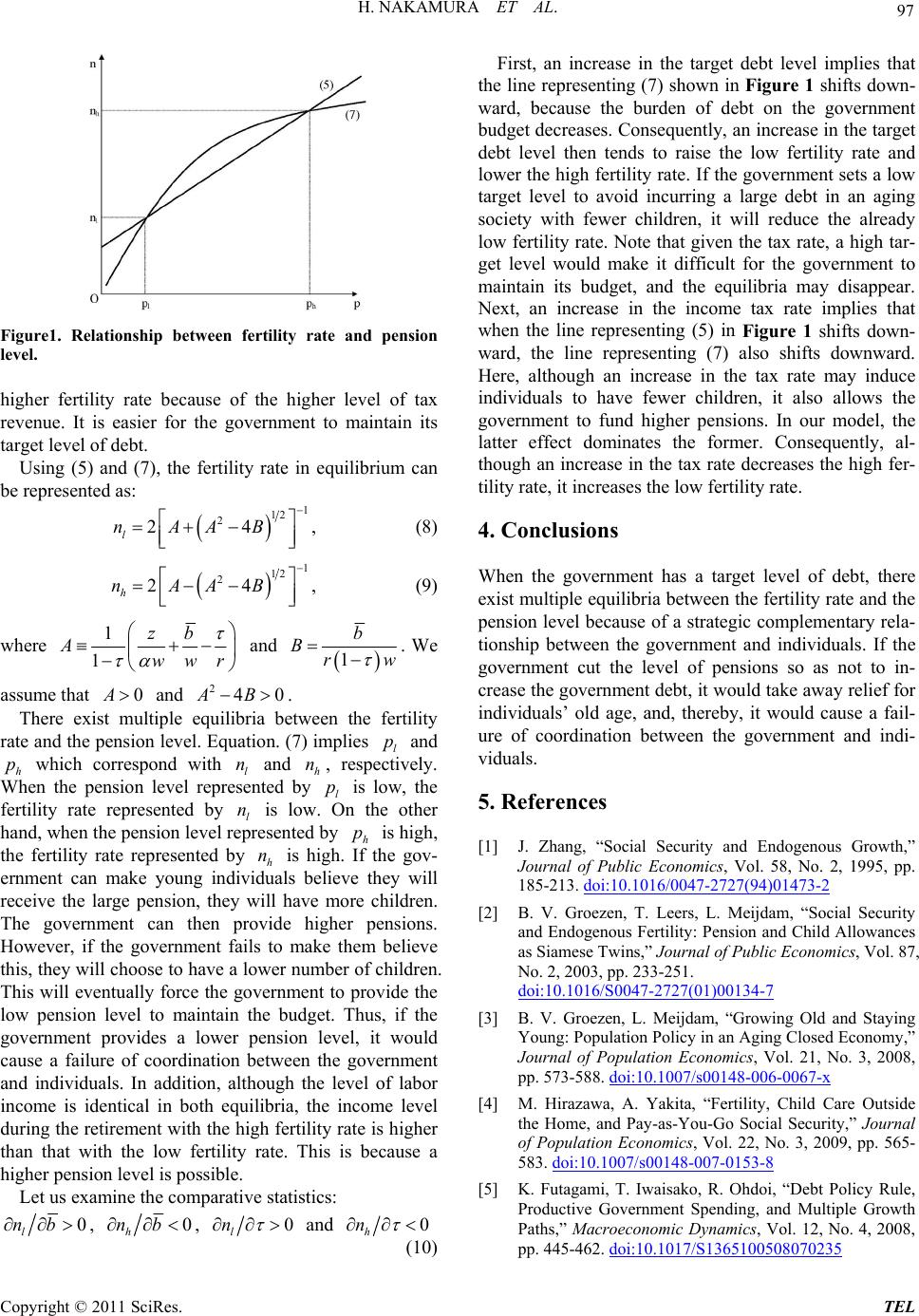
97
H. NAKAMURA ET AL.
Figure1. Relationship between fertility rate and pension
level.
higher fertility rate because of the higher level of tax
revenue. It is easier for the government to maintain its
target level of debt.
Using (5) and (7), the fertility rate in equilibrium can
be represented as:
1
12
2
24
l
nAAB
,
(8)
1
12
2
24
h
nAAB
,
(9)
where 1
1
zb
Awwr
and
1
b
Brw
. We
assume that and .
0A240AB
There exist multiple equilibria between the fertility
rate and the pension level. Equatio n. (7) implies l and
h which correspond with l and h, respectively.
When the pension level represented by l is low, the
fertility rate represented by l is low. On the other
hand, when the pension level represented by h is high,
the fertility rate represented by h is high. If the gov-
ernment can make young individuals believe they will
receive the large pension, they will have more children.
The government can then provide higher pensions.
However, if the government fails to make them believe
this, they will choose to have a lower number of children.
This will eventually force the government to provide the
low pension level to maintain the budget. Thus, if the
government provides a lower pension level, it would
cause a failure of coordination between the government
and individuals. In addition, although the level of labor
income is identical in both equilibria, the income level
during the retirement with the h igh fertility rate is higher
than that with the low fertility rate. This is because a
higher pension level is possible.
p
p n
n
np
p
n
Let us examine the comparative statistics:
0
l
nb
, 0
h
nb
, 0
l
n
and 0
h
n
(10)
First, an increase in the target debt level implies that
the line representing (7) shown in Figure 1 shifts down-
ward, because the burden of debt on the government
budget decreases. Consequently, an increase in the target
debt level then tends to raise the low fertility rate and
lower the high fertility rate. If the government sets a low
target level to avoid incurring a large debt in an aging
society with fewer children, it will reduce the already
low fertility rate. Note that given the tax rate, a high tar-
get level would make it difficult for the government to
maintain its budget, and the equilibria may disappear.
Next, an increase in the income tax rate implies that
when the line representing (5) in Figure 1 shifts down-
ward, the line representing (7) also shifts downward.
Here, although an increase in the tax rate may induce
individuals to have fewer children, it also allows the
government to fund higher pensions. In our model, the
latter effect dominates the former. Consequently, al-
though an increase in the tax rate decreases the high fer-
tility rate, it increases the low fertility rate.
4. Conclusions
When the government has a target level of debt, there
exist multiple equilibria between the fertility rate and the
pension level because of a strategic complementary rela-
tionship between the government and individuals. If the
government cut the level of pensions so as not to in-
crease the government debt, it would take away relief for
individuals’ old age, and, thereby, it would cause a fail-
ure of coordination between the government and indi-
viduals.
5. References
[1] J. Zhang, “Social Security and Endogenous Growth,”
Journal of Public Economics, Vol. 58, No. 2, 1995, pp.
185-213. doi:10.1016/0047-2727(94)01473-2
[2] B. V. Groezen, T. Leers, L. Meijdam, “Social Security
and Endogenous Fertility: Pension and Child Allowances
as Siamese Twins,” Journal of Public Economics, Vol. 87,
No. 2, 2003, pp. 233-251.
doi:10.1016/S0047-2727(01)00134-7
[3] B. V. Groezen, L. Meijdam, “Growing Old and Staying
Young: Population Policy in an Aging Closed Economy,”
Journal of Population Economics, Vol. 21, No. 3, 2008,
pp. 573-588. doi:10.1007/s00148-006-0067-x
[4] M. Hirazawa, A. Yakita, “Fertility, Child Care Outside
the Home, and Pay-as-You-Go Social Security,” Journal
of Population Economics, Vol. 22, No. 3, 2009, pp. 565-
583. doi:10.1007/s00148-007-0153-8
[5] K. Futagami, T. Iwaisako, R. Ohdoi, “Debt Policy Rule,
Productive Government Spending, and Multiple Growth
Paths,” Macroeconomic Dynamics, Vol. 12, No. 4, 2008,
pp. 445-462. doi:10.1017/S1365100508070235
Copyright © 2011 SciRes. TEL